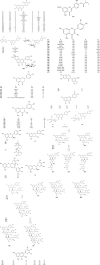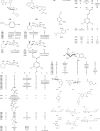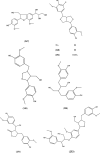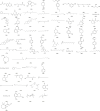Phytochemistry, Pharmacology and Medicinal Uses of Plants of the Genus Salix: An Updated Review
- PMID: 33643045
- PMCID: PMC7908037
- DOI: 10.3389/fphar.2021.593856
Phytochemistry, Pharmacology and Medicinal Uses of Plants of the Genus Salix: An Updated Review
Abstract
The Willows (genus Salix), with more than 330-500 species and 200 hybrids, are trees, shrubs or prostrate plants that are widely distributed in Africa, North America, Europe, and Asia. The genus is traditionally used in folk medicine and represents a valuable source of biologically active compounds among them salicin, a prodrug for salicylic acid. Altogether, 322 secondary metabolites were characterized in the genus including flavonoids 94) (flavonols, flavones, flavanones, isoflavones, flavan-3-ols (catechins and procyanidins), chalcones, dihydrochalcone, anthocyanins, dihydroflavonols), phenolic glycosides (76), organic acids (28), and non-phenolic glycosides (17), sterols and terpenes (17), simple phenolics 13) and lignans 7) in addition to volatiles and fatty acids (69). Furthermore, willows exert analgesic, anti-inflammatory, antioxidant, anticancer, cytotoxic, antidiabetic, antimicrobial, antiobesity, neuroprotective and hepatoprotective activities. The current review provides an updated summary of the importance of willows, their chemical composition and pharmacological activities.
Keywords: inflammation; medicinal and traditional uses; pharmacology; phytochemistry; salix.
Copyright © 2021 Tawfeek, Mahmoud, Hamdan, Sobeh, Farrag, Wink and El-Shazly.
Conflict of interest statement
The authors declare that the research was conducted in the absence of any commercial or financial relationships that could be construed as a potential conflict of interest.
Figures








References
-
- Agnolet S., Wiese S., Verpoorte R., Staerk D. (2012). Comprehensive analysis of commercial willow bark extracts by new technology platform: combined use of metabolomics, high-performance liquid chromatography–solid-phase extraction–nuclear magnetic resonance spectroscopy and high-resolution radical scavenging assay. J. Chromatogr. A. 1262, 130–137. 10.1016/j.chroma.2012.09.013 - DOI - PubMed
-
- Ahmed W., Ahmad M., Khan R. A., Mustaq N. (2016). Promising inhibition of krait snake's venom acetylcholinesterase by Salix nigra and its role as anticancer, antioxidant agent. Indian J. Anim. Res. 50, 317–323. 10.18805/ijar.10711 - DOI
-
- Argus G. W. (2006). Guide to the identification of salix (willow) in Illinois, Indiana, Ohio, and Pennsylvania. Ottawa, Ontario: Canadian Museum of Nature, 47.
Publication types
LinkOut - more resources
Full Text Sources
Other Literature Sources

